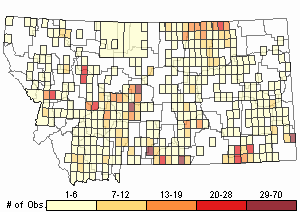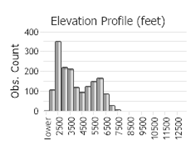View in other NatureServe Network Field Guides
NatureServe
Montana
Utah
Wyoming
Idaho
Wisconsin
British Columbia
South Carolina
Yukon
California
New York
Hairy Goldenaster - Heterotheca villosa
Other Names:
Chrysopsis villosa
Native Species
Global Rank:
G5
State Rank:
S5
C-value:
3
Agency Status
USFWS:
USFS:
BLM:
External Links
General Description
PLANTS: Perennial plants that grow from a taproot. Stems decumbent to erect, woody at the base, and 10–50 cm tall. Hairs are strigose (stiff, straight, sharp, and appressed) to hirsute (long and stiff), often stipitate-glandular (stalked glands). Source: Lesica et al. 2012.
LEAVES: Alternately arranged on the stem (cauline). Those on the lower stem petiolate and upwards becoming sessile. Leaf blades are oblanceolate to obovate in shape with smooth (entire) margins, and 1–5 cm long. Source: Lesica et al. 2012.
INFLORESCENCE: Yellow flowers in heads arranged in leafy-bracted corymbiform arrays. Flower stems (peduncles) are 0–3 cm long. Involucre is narrowly campanulate, 5–10 mm high. Involucral bracts (phyllaries) are imbricate forming 4 to 5 rows; bracts are green, narrowly lanceolate, white-margined, and glabrate to strigose, though sometimes glandular. The receptacle is nearly flat. Heads composed of yellow ray and disk florets (radiate). Fruit is a Cypsela, a specific type of achene. Source: Lesica et al. 2012.
In Montana we have five varieties: ballardii, depressa, foliosa, minor, and villosa.
Heterotheca is derived from the Greek words heteros meaning 'different' and thece meaning 'container' which refers to ray and disk cypsela being morphological different in some species (dimorphic cypsela) (Semple in Flora of North America [FNA] 2006).
Diagnostic Characteristics
At the species-level and across its full range
Heterotheca villosa is variable in stem height, leaf base shape, stem and leaf indumenta, number of flower heads, and number of florets (Semple
in FNA 2006).
In Montana this species is unique in having
these combinations of characteristics:
*Overall: Relatively low growing with predominately sessile, hairy leaves, brilliant yellow radiate flowers, and somewhat woody stems.
*Flower Heads: Yellow rays and a naked receptacle that lacks scales, awns, or bristles. Involucral bracts in 4-5 rows (series).
*Disk Florets: Pappus with both awns and capillary bristles (2 series).
*Leaves: Alternately arranged, mostly sessile, and oblanceolate to obovate in shape.
Montana has 5 varieties (Semple
in FNA 2006):
Variety foliosa
Variety minor
Variety villosa
Variety depressaVariety ballardiiSpecies Range
Montana Range
Range Descriptions

 Native
Native
Range Comments
British Columbia to Ontario in Canada south to California, Arizona, New Mexico, Texas, Illinois, and Michigan in the U.S. (Lesica et al. 2012).
Observations in Montana Natural Heritage Program Database
Number of Observations: 1973
(Click on the following maps and charts to see full sized version)
Map Help and Descriptions
Relative Density

Recency



 (Observations spanning multiple months or years are excluded from time charts)
(Observations spanning multiple months or years are excluded from time charts)
Habitat
In Montana plants occur in grasslands, fields, woodlands, streambanks, and roadsides (Lesica et al. 2012).
Plants are most abundant in dry open areas in sandy, rocky, or calcareous soils (Stubbendieck 1992).
Ecology
CULTURAL
Hairy Goldenaster was consumed by some Native American tribes. A decoction was made from the tops and stems and used as a medicine to sooth, quiet, and aid in sleeping (Stubbendieck 1992).
Reproductive Characteristics
Plants reproduce by seed.
FLOWERS
Heads composed only of ray and disc florets (radiate). Ray florets: 10 to 20, yellow, female, fertile, and with petals (ligules) of 5–9 mm long. Disk florets: 20 to 50, yellow, perfect (male and female organs present), and corolla is 4–7 mm long; Style branches are flattened with elongated appendages; pappus is dimorphic with both short scales on the outside and capillary bristles on the inside.
FRUITS
Cypsela: An achene that is one-chambered (one locule) and developed from an inferior ovary. Achenes are obconic in shape, has 4-8 ribs, is 2–3 mm long, and has strigose hairs with 4 to 8 ribs.
Management
GRAZING
Hairy Goldenaster rate as fair forage quality for sheep in the poor semi-desert areas of the western U.S. (Stubbendieck 1992).
Stewardship Responsibility
References
- Literature Cited AboveLegend:
 View Online Publication
View Online Publication Flora of North America Editorial Committee. 2006. Flora of North America North of Mexico. Vol. 20. Magnoliophyta: Asteridae, part 7: Asteraceae, part 2. Oxford Univ. Press, New York. xxii + 666 pp.
Flora of North America Editorial Committee. 2006. Flora of North America North of Mexico. Vol. 20. Magnoliophyta: Asteridae, part 7: Asteraceae, part 2. Oxford Univ. Press, New York. xxii + 666 pp. Lesica, P., M.T. Lavin, and P.F. Stickney. 2012. Manual of Montana Vascular Plants. Fort Worth, TX: BRIT Press. viii + 771 p.
Lesica, P., M.T. Lavin, and P.F. Stickney. 2012. Manual of Montana Vascular Plants. Fort Worth, TX: BRIT Press. viii + 771 p. Stubbendieck, J., S. L. Hatch, and C. H. Butterfield. 1992. North American range plants, 4th ed. University of Nebraska Press, Lincoln. 493 pp.
Stubbendieck, J., S. L. Hatch, and C. H. Butterfield. 1992. North American range plants, 4th ed. University of Nebraska Press, Lincoln. 493 pp.
- Additional ReferencesLegend:
 View Online Publication
View Online Publication
Do you know of a citation we're missing? Adhikari, S. 2018. Impacts of dryland farming systems on biodiversity, plant-insect interactions, and ecosystem services. Ph.D. Dissertation. Bozeman, MT: Montana State University. 207 p.
Adhikari, S. 2018. Impacts of dryland farming systems on biodiversity, plant-insect interactions, and ecosystem services. Ph.D. Dissertation. Bozeman, MT: Montana State University. 207 p. Boggs, K. W. 1984. Succession in riparian communities of the lower Yellowstone River, Montana. M.S. Thesis. Montana State University, Bozeman, 107 pp.
Boggs, K. W. 1984. Succession in riparian communities of the lower Yellowstone River, Montana. M.S. Thesis. Montana State University, Bozeman, 107 pp. Cope, M.G. 1992. Distribution, habitat selection and survival of transplanted Columbian Sharp-tailed Grouse (Tympanuchus phasianellus columbianus) in the Tobacco Valley, Montana. M.Sc. Thesis. Bozeman, Montana: Montana State University. 60 p.
Cope, M.G. 1992. Distribution, habitat selection and survival of transplanted Columbian Sharp-tailed Grouse (Tympanuchus phasianellus columbianus) in the Tobacco Valley, Montana. M.Sc. Thesis. Bozeman, Montana: Montana State University. 60 p. Corr, D.R. 1988. Effects of stress inducing factors on musk thistle (Carduus nutans L,) including--grass competition, Rhinocyllus conicus Froel., terminal flower loss, and insecticides. M.Sc. Thesis. Bozeman, MT: Montana State University. 86 p.
Corr, D.R. 1988. Effects of stress inducing factors on musk thistle (Carduus nutans L,) including--grass competition, Rhinocyllus conicus Froel., terminal flower loss, and insecticides. M.Sc. Thesis. Bozeman, MT: Montana State University. 86 p. Delphia, C.M., Griswold, T., Reese, E.G., O'Neill, K.M., and Burkle, L.A. 2019. Checklist of bees (Hymenoptera: Apoidea) from small, diversified vegetable farms in south-western Montana. Biodiversity Data Journal: e30062
Delphia, C.M., Griswold, T., Reese, E.G., O'Neill, K.M., and Burkle, L.A. 2019. Checklist of bees (Hymenoptera: Apoidea) from small, diversified vegetable farms in south-western Montana. Biodiversity Data Journal: e30062 Durham, R. A., D. L. Mummey, L. Shreading, and P.W. Ramsey. 2017. Phenological patterns differ between exotic and native plants: Field observations from the Sapphire Mountains, Montana. Natural Areas Journal, 37(3), 361–381.
Durham, R. A., D. L. Mummey, L. Shreading, and P.W. Ramsey. 2017. Phenological patterns differ between exotic and native plants: Field observations from the Sapphire Mountains, Montana. Natural Areas Journal, 37(3), 361–381. Eggers, M.J.S. 2005. Riparian vegetation of the Montana Yellowstone and cattle grazing impacts thereon. M.Sc. Thesis. Montana State University, Bozeman, MT. 125 p.
Eggers, M.J.S. 2005. Riparian vegetation of the Montana Yellowstone and cattle grazing impacts thereon. M.Sc. Thesis. Montana State University, Bozeman, MT. 125 p. Grove, A.J. 1998. Effects of Douglas fir establishment in southwestern Montana mountain big sagebrush communities. M. Sc.Thesis. Bozeman, MT: Montana State University. 150 p.
Grove, A.J. 1998. Effects of Douglas fir establishment in southwestern Montana mountain big sagebrush communities. M. Sc.Thesis. Bozeman, MT: Montana State University. 150 p. Hale, K.M. 2007. Investigations of the West Nile virus transmission cycle at Medicine Lake National Wildlife Refuge, Montana, 2005-2006. M.Sc. Thesis. Bozeman, MT: Montana State University. 74 p.
Hale, K.M. 2007. Investigations of the West Nile virus transmission cycle at Medicine Lake National Wildlife Refuge, Montana, 2005-2006. M.Sc. Thesis. Bozeman, MT: Montana State University. 74 p. Harvey, S.J. 1990. Responses of steppe plants to gradients of water soil texture and disturbance in Montana, U.S.A. Ph.D. Thesis. Bozeman, MT: Montana State University. 34 p.
Harvey, S.J. 1990. Responses of steppe plants to gradients of water soil texture and disturbance in Montana, U.S.A. Ph.D. Thesis. Bozeman, MT: Montana State University. 34 p. Johnson, T. W. 1982. An analysis of pack and saddle stock grazing areas in the Bob Marshall Wilderness. M.Sc.Thesis. Bozeman, MT: Montana State University. 105 p.
Johnson, T. W. 1982. An analysis of pack and saddle stock grazing areas in the Bob Marshall Wilderness. M.Sc.Thesis. Bozeman, MT: Montana State University. 105 p. Jones, W. W. 1901. Preliminary flora of Gallatin County. M.S. Thesis. Bozeman, MT: Montana State College. 78 pp.
Jones, W. W. 1901. Preliminary flora of Gallatin County. M.S. Thesis. Bozeman, MT: Montana State College. 78 pp. Lesica, P., M.T. Lavin, and P.F. Stickney. 2022. Manual of Montana Vascular Plants, Second Edition. Fort Worth, TX: BRIT Press. viii + 779 p.
Lesica, P., M.T. Lavin, and P.F. Stickney. 2022. Manual of Montana Vascular Plants, Second Edition. Fort Worth, TX: BRIT Press. viii + 779 p. Martinka, R.R. 1970. Structural characteristics and ecological relationships of male blue grouse (Dendragapus obscurus (Say)) territories in southwestern Montana. Ph.D Dissertation. Bozeman, MT: Montana State University. 73 p.
Martinka, R.R. 1970. Structural characteristics and ecological relationships of male blue grouse (Dendragapus obscurus (Say)) territories in southwestern Montana. Ph.D Dissertation. Bozeman, MT: Montana State University. 73 p. Nyberg, H.E. 1980. Distribution, movements and habitat use of mule deer associated with the Brackett Creek winter range, Bridger Mountains, Montana. M.Sc. Thesis. Bozeman, MT: Montana State University. 106 p.
Nyberg, H.E. 1980. Distribution, movements and habitat use of mule deer associated with the Brackett Creek winter range, Bridger Mountains, Montana. M.Sc. Thesis. Bozeman, MT: Montana State University. 106 p. Pallister, G.L. 1974. The seasonal distribution and range use of bighorn sheep in the Beartooth Mountains, with special reference to the West Rosebud and Stillwater herds. M.Sc. Thesis. Bozeman, MT: Montana State University. 67 p.
Pallister, G.L. 1974. The seasonal distribution and range use of bighorn sheep in the Beartooth Mountains, with special reference to the West Rosebud and Stillwater herds. M.Sc. Thesis. Bozeman, MT: Montana State University. 67 p. Quire, R.L. 2013. The sagebrush steppe of Montana and southeastern Idaho shows evidence of high native plant diversity, stability, and resistance to the detrimental effects of nonnative plant species. M.Sc. Thesis. Bozeman, MT: Montana State University. 124 p.
Quire, R.L. 2013. The sagebrush steppe of Montana and southeastern Idaho shows evidence of high native plant diversity, stability, and resistance to the detrimental effects of nonnative plant species. M.Sc. Thesis. Bozeman, MT: Montana State University. 124 p. Scow, K.L. 1981. Ecological distribution of small mammals at Sarpy Creek, Montana, with special consideration of the Deer Mouse, Peromyscus maniculatus. M.Sc. Thesis. Bozeman, Montana: Montana State University. 73 p.
Scow, K.L. 1981. Ecological distribution of small mammals at Sarpy Creek, Montana, with special consideration of the Deer Mouse, Peromyscus maniculatus. M.Sc. Thesis. Bozeman, Montana: Montana State University. 73 p. Seipel, T.F. 2006. Plant species diversity in the sagebrush steppe of Montana. M.Sc. Thesis. Bozeman, MT: Montana State University. 87 p.
Seipel, T.F. 2006. Plant species diversity in the sagebrush steppe of Montana. M.Sc. Thesis. Bozeman, MT: Montana State University. 87 p. Semple, J.C. 1996. A Revision of Heterotheca Sect. Phyllotheca (Nutt.) Harms (Compositae: Astereae): the Prairie and Montane Goldenasters of North America. University of Waterloo Biology Series 37: 1-164.
Semple, J.C. 1996. A Revision of Heterotheca Sect. Phyllotheca (Nutt.) Harms (Compositae: Astereae): the Prairie and Montane Goldenasters of North America. University of Waterloo Biology Series 37: 1-164. Simanonok, M. 2018. Plant-pollinator network assembly after wildfire. Ph.D. Dissertation. Bozeman, MT: Montana State University. 123 p.
Simanonok, M. 2018. Plant-pollinator network assembly after wildfire. Ph.D. Dissertation. Bozeman, MT: Montana State University. 123 p. Skilbred, Chester L. 1979. Plant succession on five naturally revegetated strip-mined deposits at Colstrip, Montana. M.Sc. Thesis. Bozeman, MT: Montana State University. 128 pp.
Skilbred, Chester L. 1979. Plant succession on five naturally revegetated strip-mined deposits at Colstrip, Montana. M.Sc. Thesis. Bozeman, MT: Montana State University. 128 pp. Skinner, K.F. 1995. Plant and grasshopper community composition: indicators & interactions across three spatial scales. M.Sc. Thesis. Bozeman, MT: Montana State University. 144 p.
Skinner, K.F. 1995. Plant and grasshopper community composition: indicators & interactions across three spatial scales. M.Sc. Thesis. Bozeman, MT: Montana State University. 144 p. Steerey, W. F. 1979. Distribution, range use and population characteristics of Mule Deer associated with the Schafer Creek winter range, Bridger Mountains, Montana. M.Sc. Thesis. Bozeman, Montana: Montana State University. 119 p.
Steerey, W. F. 1979. Distribution, range use and population characteristics of Mule Deer associated with the Schafer Creek winter range, Bridger Mountains, Montana. M.Sc. Thesis. Bozeman, Montana: Montana State University. 119 p. Tuinstra, K. E. 1967. Vegetation of the floodplains and first terraces of Rock Creek near Red Lodge, Montana. Ph.D dissertation. Montana State University, Bozeman 110 pp.
Tuinstra, K. E. 1967. Vegetation of the floodplains and first terraces of Rock Creek near Red Lodge, Montana. Ph.D dissertation. Montana State University, Bozeman 110 pp. Wiman, N.G. 2001. Dynamics of leafy spurge (Euphorbia esula L.) infested plant communities influenced by flea beetles in the Aphthona complex (Colepotera: Chrysomelidae). M.Sc. Thesis. Bozeman, MT: Montana State University. 148 p.
Wiman, N.G. 2001. Dynamics of leafy spurge (Euphorbia esula L.) infested plant communities influenced by flea beetles in the Aphthona complex (Colepotera: Chrysomelidae). M.Sc. Thesis. Bozeman, MT: Montana State University. 148 p. Wood, A.K. 1987. Ecology of a prairie mule deer population. Ph.D. Dissertation. Bozeman, MT: Montana State University. 205 p.
Wood, A.K. 1987. Ecology of a prairie mule deer population. Ph.D. Dissertation. Bozeman, MT: Montana State University. 205 p.
- Web Search Engines for Articles on "Hairy Goldenaster"





